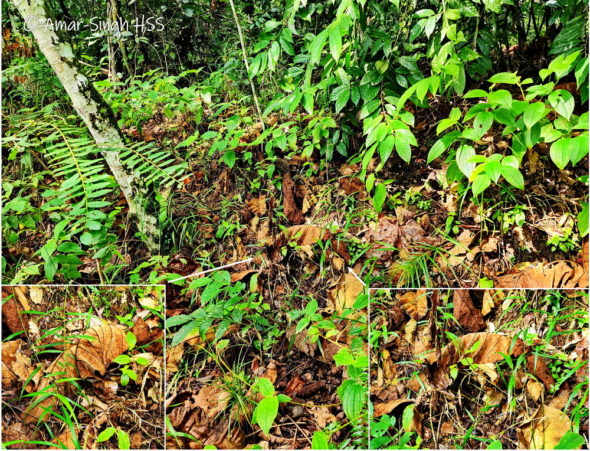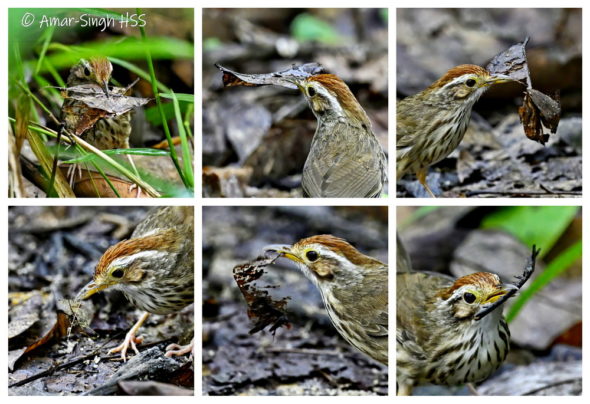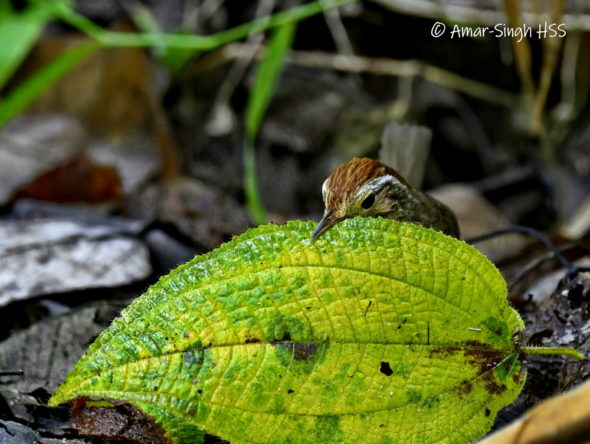It was a dark morning at the Kledang Saiong Forest Reserve on 9th February 2023 but I decided to visit as this, now threatened green lung, that stretches from near Papan to Chemor has an enormous diversity of bird life. As I was walking one of the trails, a babbler ran across in front of me. I stood still and waited, and then spotted it in the undergrowth, a Puff-throated Babbler (Pellorneum ruficeps). I soon recognised it was nest-building as it was collecting material. I remained where I was and was pleased the bird continued despite my presence (I was 4-5 meters away from the nest). I watched for 35 minutes and saw numerous nest building activities. Key observations include:
1. Only one bird was involved in the nest building, the presumed female. The partner, presumed male, was nearby and was calling continually – the classical territorial calls that are repeated for long periods.
2. The nest was located on the ground, in the undergrowth and leaf litter, adjacent to a tree and with a small slope at the back. It was built under two, large fallen leaves (see image 1).

3. A wide range of material was chosen for the nest (see composite image 2 and image 3). This included leaf skeletons, dried leaves, fibre, and twigs/sticks. Initially material was selected at 5-6 meters from the nest, but once the bird became more comfortable with me, it collected material from 1-2 meters from the nest site.


4. The bird seemed very selective about nesting material. At times it would pick up an item and then discard it as not suitable (see image 4 of a large ‘fresh’ that was picked up but subsequently discarded).

5. The bird would make calls whenever it left the nest. I have not heard such calls made by Puff-throated Babbler before. The calls were short ‘chittering’ sounds with an occasional longer whistle. A call recording can be found here: https://xeno-canto.org/779383
6. Twice the bird stopped nest building to forage on the ground in front of me. On both occasions it appeared to pick up a small beetle-like insect to feed on.
7. Due to the location of the nest and foreground vegetation, it was not possible to use my long lens to do a video from a distance. I was close enough to use my handphone to get a short video (limited clarity and contrast). A video recording here: https://youtu.be/PGh0PpOVT5M
After 35 minutes I left to allow the birds to continue without my disturbance.
On local nests, Wells (2007) describes two nests built on the ground in the leaf litter, one that was roofed by leaves. Details are limited locally. Birds of the World (2020) describes nests as “a large, flimsy ball or dome, with entrance at side, …. made of dead bamboo or other leaves, grasses, moss, plant fibres and dead twigs …. placed on ground among dead leaves, at foot of bush or clump of grass or sheltered by stone.”
Research by Khamcha et al (2018) on roadside edge on nest predators and nest survival of Asian tropical forest birds, included 39 Puff-throated Babbler nests. All were domes on the ground. Of these nests monitored, only 9 survived. I have concerns that the nest I saw may be predated as it is located close to the forest fringe.
References:
1. Wells, D.R. (2007). The birds of the Thai-Malay Peninsula: Vol. 2 (Passerines). Christopher Helm, London.
2. Collar, N. and C. Robson (2020). Puff-throated Babbler (Pellorneum ruficeps), version 1.0. In Birds of the World (J. del Hoyo, A. Elliott, J. Sargatal, D. A. Christie, and E. de Juana, Editors). Cornell Lab of Ornithology, Ithaca, NY, USA. https://doi.org/10.2173/bow.putbab1.01.
3. Daphawan Khamcha, Larkin A. Powell, George A. Gale (2018). Effects of roadside edge on nest predators and nest survival of Asian tropical forest birds. Global Ecology and Conservation, Vol 16,e00450. https://www.sciencedirect.com/science/article/pii/S2351989418301756
Dato’ Dr Amar-Singh HSS
Ipoh, Perak, Malaysia
Note to readers: If you like this post please tap on the Like button at the left bottom of page.









One Response
marvellous.